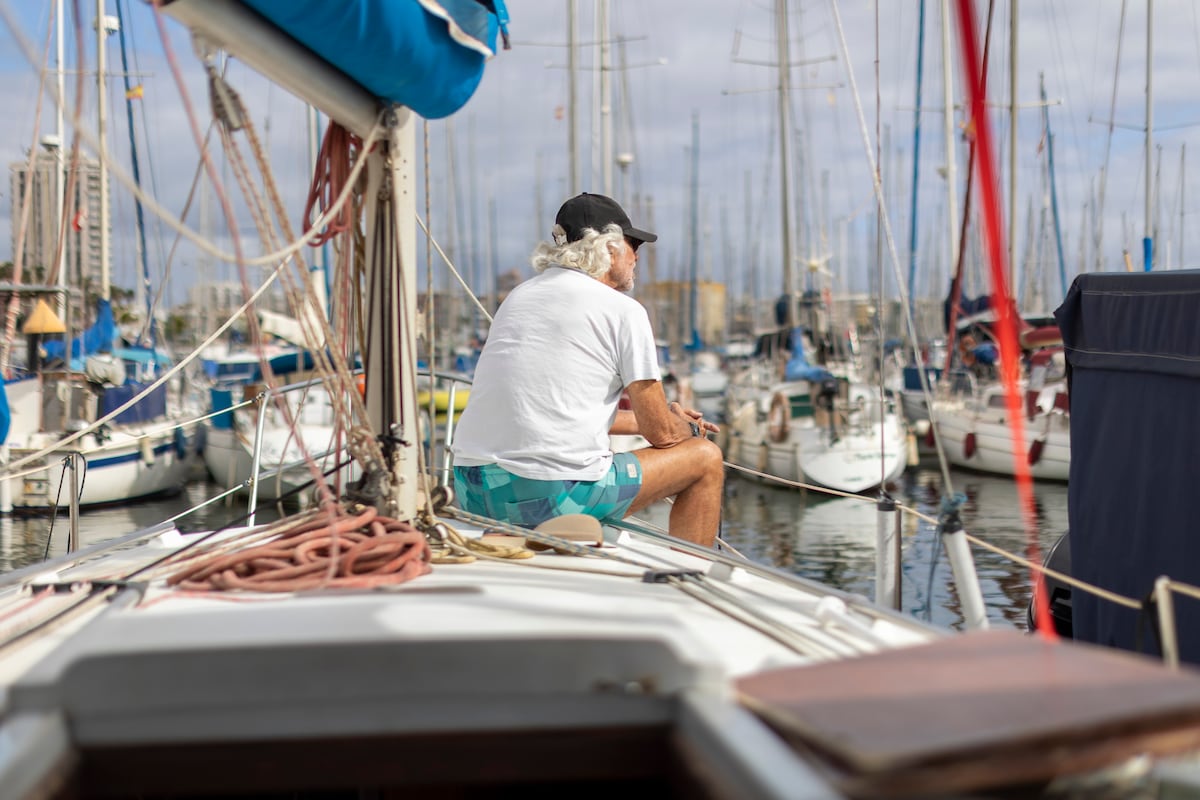Las Palmas Marina — known in the city as simply “the marina” — isn’t only the largest recreational dock in Spain’s Canary Islands, with nearly 1,400 berthing spots. Over the decades, it has become a hit for nightclubs and restaurants, as well as a way of life for several dozen people.
One day, some of them decided that “living on land wasn’t an option,” as Antonio explains to EL PAÍS via WhatsApp. “I had a dream: to buy a sailboat, sail and live on it.”
Others, however, don’t tell such an inspiring story. For them, a boathouse is the last resort after being priced out of the real estate market.
Rafael (a pseudonym) is 82-years-old. He retired in 2008. The last 30 years of his professional life were spent as a journalist, earning commissions as a freelancer. “Nobody wanted to give me a regular contract,” he shrugs. “Suddenly, I found myself retired, with a pension of €500 euros [a month] [$540].”
For nine years, he lived in the apartment of one of his daughters. But in 2017, she wanted to get rid of the apartment, and Rafael realized that with his income, it would be impossible to find a place in the real estate market. “Fortunately,” he says, “I made an agreement with my daughter that, if I managed to sell [the apartment] for more than the price she was asking, I would keep the difference.” That difference ended up being about €20,000, or the equivalent of $22,000.
A friend gave him the idea of what to use it for: go live on a boat. “I thought they were very expensive, but if you’re willing to pay cash, you can find bargains.” He ended up buying a 30-foot-long sailboat from a Frenchman who wanted to leave the Spanish archipelago and return to his country. Rafael has lived on the vessel ever since.
“Many people,” says the Spanish sailor Nin, 60, in a telephone conversation with EL PAÍS, “are buying old, run-down boats, because it’s the only option they have, due to the housing situation. You see it here every day.”
One of these individuals — who asks to remain anonymous — says that he has decided to live on his boat because he cannot afford rent. “I barely earn the minimum wage, where am I going to live with that? Here, I can have a decent life and I don’t bother anyone. The problem is that they [the authorities] want to kick us out,” he laments.
The population of the Canary Islands has increased by 26% so far over the past 25 years. The archipelago is now home to nearly 2.2 million people. Immigration — mostly from other parts of Spain or countries such as Italy (the largest expat population, with 49,987 people) or the United Kingdom (29,631) — is the main cause of population growth. They settle down because they’re attracted by the living conditions. This demographic shift — along with the unstoppable rise in tourism — has been accompanied by the explosion of vacation rentals, which, among other factors, have put pressure on the housing market and have made it difficult for residents to find a home. This was one of the triggers of large protests that took place on the islands last spring.
Between January and September 2024, rental prices have risen by almost 9% in the Canary Islands, the fourth most expensive region of Spain, after the Balearic Islands, Madrid and Catalonia, according to prices on popular real estate websites. In San Bartolomé de Tirajana — the main tourist town in the Canary Islands — the average price is $220 per square foot, not far off from major cities such as Madrid and Barcelona. In Arona, on the island of Tenerife, it’s around $200. The consequence is that, throughout the Canary Islands, on the outskirts of cities, shanty towns have become more common: many hotel and restaurant workers live there, either in substandard housing, or in their own vehicles.
“What I pay is less than €100 [$110] a month,” Rafael explains. “That’s how I live in the center of Las Palmas. It’s nothing compared to the current housing market.” The price includes electricity and water. Boat owners can also use the services on the dock, which include a shower with hot water and a bathroom. “Everyone is going crazy looking for boats in the port, you know?” he says.
It will be difficult for them to imitate Rafael, for several reasons. To start with, there’s a waiting list of over 100 people for a spot, because Las Palmas Marina has the cheapest mooring prices in Spain. The costs at other docks are higher, but they’re still much cheaper than property prices across the Canary Islands.
Is it legal to live on a boat? “The Port Law itself doesn’t prohibit converting a boat into a home,” explains attorney Carlota Zapata, in a telephone conversation with EL PAÍS. “What happens is that you have to be very aware of what the Port Authority requires in its ordinances. Some can prohibit it.” The second thing you must do, she continues — if you want to live on a boat and want to get it registered — is to go to the city hall and check if it allows for the possibility. “Many [municipalities] require a document from the Port Authority which proves you’re living at a marina,” the lawyer adds.
This requirement is an obstacle, at least, in Las Palmas de Gran Canaria. As the Port Authority of Las Palmas doesn’t look favorably upon this practice, it has prohibited the possibility in its ordinances since 2019. A spokesperson for the management of the marina says in an email that the prohibition is justified “on several grounds.” The marinas “are not designed or intended, in general terms, for permanent residential use.” The “houseboats” are “continuously moored or anchored, often being inactive for navigation, with the consequences that this entails for the safety and operation” of the facilities. The Port Authority has also eradicated the practice of boat rentals on platforms such as Airbnb since 2019. Other port authorities — such as those who oversee Port Olímpic, in Barcelona — are also trying to control this.
“They can’t kick you out,” Nin complains. “The law itself states that, if you’ve been there for more than six months, you’re considered to have your [home] base in the port.” The sailor says that the authorities once tried to evict him: they said that his sailboat was longer than its 32-foot length. He ultimately won the lawsuit and returned to his dock, where he pays about $162 a month in fees. “The real problem is that the management wants to turn this into a shopping center — the boats are the least important thing,” he notes.
In Las Palmas de Gran Canaria, there are currently 259 people registered in the marina, according to data from the City Council. However, sources from the council clarify that this data was collected prior to 2019, when the Port Authority published the ordinance that prohibited living on a boat. The regulation even vetoes the possibility of anchored boats being used for holiday rental purposes, whether the contracts are “between individuals or [established] through electronic platforms or companies of any kind dedicated to this type of activity.”
A municipal spokesperson clarifies: “For years, I haven’t seen anyone registered on the dock.” He explains that it’s possible that this number has been reduced because they may be foreigners who have left the country and haven’t reported their departure.
Those who live in the ports say that their boats aren’t shacks and that they do, in fact, sail occasionally. The hull, the sails, the engines — everything works perfectly, they affirm. “Circumstances forced me to move here, but it’s a good life,” Rafael concludes. “There isn’t a mean neighbor upstairs. On the contrary, there’s a lot of neighborliness… you get a sense of the camaraderie of the sea.”
Sign up for our weekly newsletter to get more English-language news coverage from EL PAÍS USA Edition














